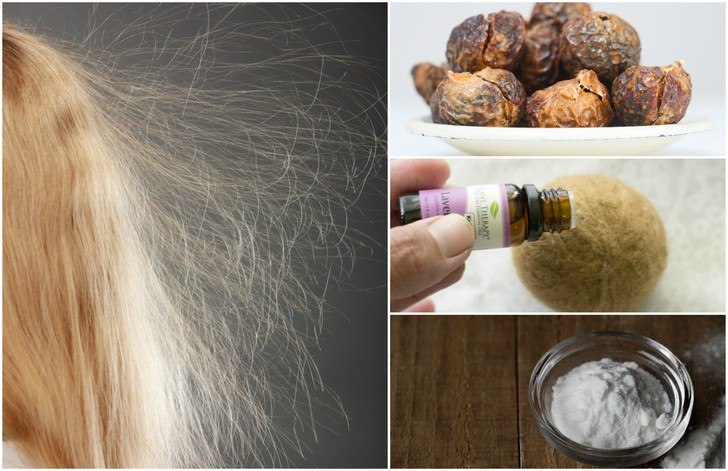
The phenomenon of static cling – where an overabundance of positively charged ions fills the air – is a relatively modern annoyance. Though it is more prevalent during wintertime due to low humidity levels, the clothes dryer is chiefly responsible for generating static electricity since the tumble cycle causes rubbing and friction on the fabrics, dubbed the triboelectric effect.
In response to the new problem created by mechanical dryers, the industry responded by introducing fabric softeners and dryer sheets to combat static cling. Both work essentially the same way: they coat your clothing in synthetic chemicals that are negatively charged to neutralize static.
The chemical compounds used in fabric softeners have been known to cause rashes and other skin problems through fabric to skin contact. When breathed in over an extended period of time, they can create lifelong respiratory problems like asthma. Several of the principle ingredients are known carcinogens, hormone disruptors, and neurotoxins. And that’s not to mention the undisclosed soup of toxins that are labelled simply as “fragrance”.
We shouldn’t have to compromise our health in order to avoid static cling! Here are 12 natural ways to prevent socks from sticking to your pants and your hair from standing on end:
1. Hang Clothes to Dry
You can eliminate static cling entirely eschewing the rough and tumble of the dryer and hanging your fabrics up to dry. Not only will you save money on energy, it’s much kinder to the planet and clothing left outside to dry on the line smells amazingly fresh. Alternatively, using a drying rack indoors helps bump up humidity levels passively inside the home.
2. Use Soap Nuts
An environmentally friendly alternative to synthetic detergents, using soap nuts in the wash is a much purer way to do your laundry. Because it is a natural softener, soap nuts can help thwart the scourge of static cling too.
You can buy soap nuts relatively inexpensively from here on Amazon.
3. Make Your Own Dryer Sheets
In lieu of using chemically laden dryer sheets, you can make your own using all natural ingredients. All you need is white vinegar, essential oils of your choice, a spray bottle, and several strips of cloth – which can be sourced from old t-shirts, towels, and the like. See the complete tutorial here.
4. Wool Dryer Balls
Another crafty way to cut down on static electricity in the laundry is to make some wool dryer balls. Tossing 4 to 5 dryer balls into your dryer helps to absorb moisture which creates a more humid environment within the dryer, thereby reducing static. They have the added benefit of speeding up drying times and softening your fabrics. You’ll need a skein of 100% wool yarn (since synthetic and blended fibers won’t felt), as well as an old pillowcase, and your favorite essential oil. You can get the full tutorial here, or if you don’t fancy a DIY, you can purchase them from here.
5. Vinegar Fabric Softener
White vinegar is a natural fabric softener that can be added to your washing machine’s rinse cycle by pouring a ¼ cup of undiluted vinegar into the fabric softener dispenser or into a Downy Ball.
Bonus: using white vinegar also cleans and removes soap residue from the washing machine.
6. Add Baking Soda
There are so many wonderful uses for baking soda around the home, and here is yet another one: add a ¼ to a ½ cup of baking soda, along with laundry soap, to your washing machine to help prevent static. Baking soda is another natural fabric softener that will also keep whites white and colors bright.
7. Use a Humidifier
Because dry air is like a breeding ground for static electricity, humidifying the air in your home can help mitigate the shocks of positively charged ions – especially if your home is carpeted, or if you have lots of plastic toys and electronics scattered about.
In addition to combatting static, humidifiers will naturally moisturize dry skin and hair. It also helps stem the spread of viruses like the flu, which tends to thrive in low humidity during the winter months. This is currently reviewed as the best humidifier on Amazon.
8. Use a Metal Safety Pin
When an article of clothing is already staticky, simply attach a metal safety pin to the inner hem. Metal conducts electricity and will help discharge the static. If you find yourself without a safety pin in the moment, any metal object will do – try slipping clothing through a metal hanger or by grounding yourself by touching a large metal object such as a lamp post or a fence.
9. Wear Natural Fibers
Synthetic fabrics like polyester, rayon, and nylon generate, and hold on to, static electricity when rubbed together. Plant-based fibers like cotton and bamboo are neutrally charged and won’t produce static when tumbled together. Although protein fibers like wool do carry a slight positive charge, they don’t stow electricity nearly as well as man-made fabrics.
10. Shake it Out
Shaking out each individual piece of laundry as soon as the dryer is finished running can help prevent static from settling into the fabrics.
11. Use a Wooden Hair Brush
If you’d rather your hair not look like you just touched a Van de Graff generator, you may want to ditch the plastic comb. To dispel staticky hair, use a metal or rubber comb. Better yet, wooden hair brushes are not only anti static, they are gentle on the hair and scalp and help to evenly distribute the skin’s natural oils for superior hair conditioning.
12. Moisturize
Since dry skin also carries a positive electrical charge, apply a soothing body butter to the dermis before putting on your clothes for the day. Getting into this routine will give you beautiful skin and prevent your garments from sticking to your flesh. Working a little bit of lotion through your tresses is also a quick fix for static hair too.
